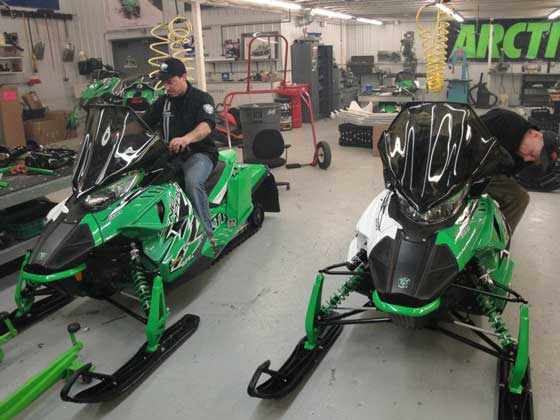
Just after winning the first USCC cross-country of the season, but before he jetted off to contest the Soo 500 enduro, Brian Dick (L) and his dad, Paul, prepped and shipped two race sleds for the upcoming Alaska Iron Dog race.
Paul has experience in the Iron Dog, but this will be Brian’s first attempt at the famed Alaskan cross-country that pits two-person teams against some truly brutal conditions (as well as other teams).
The goal for these two is to finish well, which means they first must finish. In the Iron Dog, durability and fuel range are more important that terminal velocity, so the work they and their crew did to their 2012 Arctic Cat Sno Pro 600 XC sleds emphasized bullet-proofing, storage and comfort.
Attention to detail is critical to any race program, and these guys started by tearing stuff down. As the lead engineer for the Sno Pro 600 race sled, Brian could probably do this in his sleep. Same too for his mechanic, Joe Lesmiester.
For this project, the team did most of their work in the Team Arctic Race Shop.
The crew started with fresh sleds that hadn’t been raced.
In order to run on the 87 octane fuel provided by the race, the 600 race engine was de-tuned with lower compression heads and double-ring pistons. These race motors are pre-mix only.
Storage is another key ingredient to a successful Iron Dog program, so the crew modified the seat cover to incorporate a zippered rear storage pouch large enough to contain a tool kit, oil measuring cup and a few spare parts like brake & throttle levers.
Crazy amounts of snow in the area of Alaska where the race takes place which, in conjunction with bitter cold temps, means snow dust can be a problem. High-impact plastic is placed under the running board holes prevents some of the snow from swirling up from the track and posing problems with goggles, gear and visibility.
Here’s an underside shot of the running boards. The suspension is stock, but with every nut and bolt given a drop of red Loc-Tite and torqued to spec.
More custom, high-impact plastic was added in the form of a skid-plate on the bellypan.
A tall windshield aids in the comfort factor. Check out this clever idea: Each sled has two windshields (placed together). That way if one rider busts his up, the other rider has a spare. Smart!
To add more range, custom aluminum fuel tanks were fabricated and affixed like saddlebags to the rear of the seat/tunnel. Each tank holds slightly more than 2 gallons.
The cockpit of each sled incorporates additional storage via Arctic Cat accessory bags. The end of the brake lever was chopped off to clear the stacked windshields. The stock speedo/gauge was pulled to provide room for a custom-bracket for the needed GPS.
As a just-in-case piece of prevention, remote-reservoir, coil-over FOX shox replace the stock EVOL Float shocks. In the event of a seal getting nicked and the nitrogen charge leaks, the coil-over units would still keep the sled level and rideable.
Final tweaks to the handlebar and control-lever positions, and these sleds are done! The sleds were then shipped to Alaska, where they’ll be waiting for Brian and Paul prior to the Feb. 19 race start in Big Lake by Wasilla.
The race heads from Big Lake/Wasilla to Nome, then retraces part of the route backwards before heading to the finish in Fairbanks for a total of 2,031 miles. Epic!
CLICK HERE for the official Iron Dog Website.
I wish the best of luck to Brian, Paul and all the other Team Arctic (and competitive brand) teams in this year’s race.
Thanks for reading.
